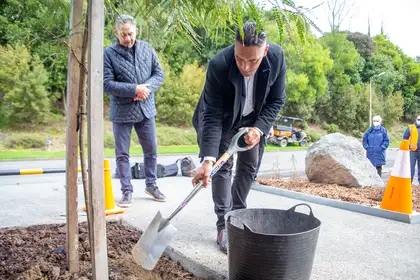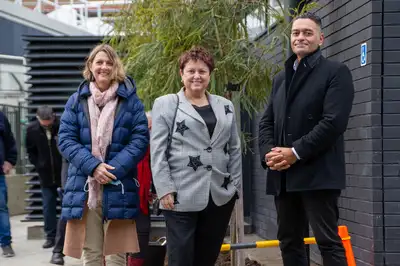
Deputy Vice-Chancellor Māori Professor Meihana Durie during the tree planting for Matariki.
The trees were planted outside Tāwharau Ora, the School of Veterinary Science, which in recent years has made a significant commitment to proactively growing the number of Māori veterinary students through its rapidly growing Māori admissions programme.
Associate Professor Hone Morris, who helped to lead the planting of indigenous trees across the campus during Matariki, provided insight into the significance of planting new trees at this time of year. He was supported by Reupena Tawhai, Co-Chair of Te Matawhānui, the Māori staff network, and Deputy Vice-Chancellor Māori Professor Meihana Durie, who each provided karakia to acknowledge the occasion. The event was attended by staff from across the University, including Vice-Chancellor Professor Jan Thomas, and Deputy Head of School Tāwharau Ora, School of Veterinary Science Professor Wendi Roe.
Professor Roe said the event helped to recognise and celebrate the ongoing work of the School in recent years in giving greater recognition and focus to Māori priorities, educational aspirations, and curriculum.
"The School made a decision some time ago to partner more closely with Māori and Rangitāne to ensure that we can support Māori and iwi aspirations in this space. Planting is important for the journey that our School and the rest of the university are on as it signifies the importance of Matariki, a time of reflection and new beginnings," Professor Roe says.
Professor Durie also acknowledged the journey of Tāwharau Ora in recent years.
“Tāwharau Ora have undertaken a strong commitment to ensure that a new generation of Māori veterinarians can study and thrive in an environment that recognises the importance of connections and relationships with Māori and with mana whenua. The new precinct that was opened recently by Rangitāne places strong emphasis on Rangitāne kōrero and traditions, and the planting of kōwhai reaffirms the journey that Tāwharau Ora have embarked upon,” Professor Durie says.
The three kōwhai trees acknowledge our three campuses: Ōtehā, Turitea, and Pukeahu.
Planting trees, or te whakatō rākau, signifies new life and new beginnings and is a strong theme throughout Puanga and Matariki celebrations. Matariki itself has a deep association with kai from planting to growing, hunting to gathering, and food storage. Historically, many Māori communities would plant a sacred garden at the rising of the Matariki. Te Kunenga ki Pūrehuroa Massey University has planted indigenous trees on campus during Matariki for over ten years. The planting also contributes to the university’s sustainability goals.
Professor Durie reflected on the role that Professor Rangi Mātāmua has played in raising public awareness and acknowledgement of Matariki.
"The work of Professor Rangi Mātāmua, Te Pūtahi-a-Toi, has played an immense role in driving wider recognition of Matariki and has now led to a national public holiday. Professor Mātāmua, together with a growing number of Māori astronomers and māramataka experts, are bringing an exciting and compelling kaupapa to the nation's consciousness which is something to be very proud of,” Professor Durie says.
Kōwhai trees are an important medicinal plant to Māori and an important seasonal nectar food source for native birds. Native birds such as tūī, korimako, kākā, kererū/kūkū/kukupa, feed off the leaves and flowers. Kōwhai is also well known for its large bell-shaped yellow flowers. As the kōwhai tree flowers, it is often read by Rangitāne as a sign of heavy rainfall. But for some coastal iwi, it means that karengo and kina are ready for harvesting.

Deputy Head of School Tāwharau Ora, School of Veterinary Science Professor Wendi Roe, Vice-Chancellor Professor Jan Thomas and Deputy Vice-Chancellor Māori Professor Meihana Durie.